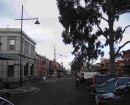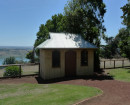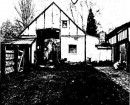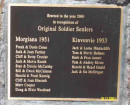STATE RESEARCH FARM
600 SNEYDES ROAD AND 4 RESEARCH CLOSE WERRIBEE, WYNDHAM CITY
-
Add to tour
You must log in to do that.
-
Share
-
Shortlist place
You must log in to do that.
- Download report


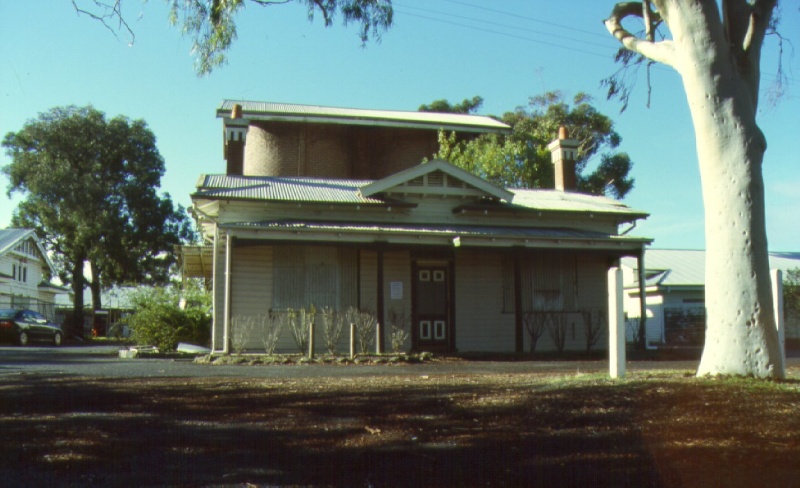

Statement of Significance
The Central Research Farm, now known as the State Research Farm, was established to support for the Closer Settlement programme under which, from 1898, parts of a number of large squatting era land holdings had been resumed and broken into farms intended for dairying, wheat growing and mixed farming in Victoria. Twenty thousand acres of the Chirnside's Werribee Estate had been acquired for closer settlement purposes in 1906. In 1912, an area of 1167 acres of this land was acquired by the Department of Agriculture for the establishment of a Research Farm. The first trials and experiments undertaken by the State Research Farm were concerned with soil renovation, rotation of crops, improvement of wheat and other cereals, irrigation practices, improvement of pastures, breeding and feeding of livestock, research into soil properties and meteorological observations.
The State Research Farm, Werribee is of historical and scientific significance to the State of Victoria.
The State Research Farm is historically significant as it illustrates a change in agriculture from European agricultural practices to practices specific to Australia's climate and conditions. The original buildings, designed as a model demonstration farm, constitute an important relic of a significant phase of Victoria's agricultural history.
-
-
STATE RESEARCH FARM - History
CONTEXTUAL HISTORY:
Agriculture in Victoria has had a long history of research and experimentation. Experimental farm buildings and cropping practices were developed to respond to Australia’s unique climatic and environmental conditions, to take advantage of natural resources and boost agricultural production. (Susan Jennison ‘Experimental and Model Farms’ in Allen, Richard (ed). Farm Buildings in Victoria to 1938,)
The first experimental farm in Victoria was established in 1858 at Royal Park under the direction of the Board of Agriculture and experimented on numerous crop varieties, market gardens and sheep. This was a short-lived venture due to lack of public funds and in 1862 was privately leased. The Board of Agriculture was superseded by the new Department of Agriculture in 1872, its role concentrating on research and advice to farmers.
Victoria became a major exporter of wheat, butter, canned and frozen meat, dried, canned and fresh fruit between 1870 and 1914, in addition to the established wool trade. (Susan Priestley (1984) The Victorians: Making Their Mark). This transformation was aided by a trend towards smaller land holdings as a result of the break up of large pastoral squatting runs and the integration of wool with lamb production. The Werribee district illustrates this trend. George Chirnside’s conversion from a wool station into a dairy farm and other mixed farm enterprises, resulted in land being available for the establishment of the State Research Farm and other surrounding rural allotments. The area was considered at the time to be some of the worst agricultural land on the Werribee estate. (May, A. A Background History of the City of Werribee. Ministry for Planning and Environment. 1989)
From 1909, the State Rivers Commission supervised the subdivision of properties into irrigation blocks, grading them for proper water flow and channelling them ready for settlement. In accordance with the Closer Settlement Scheme, these irrigation blocks averaged between twenty-seven to eighty six-acres each. By 1911 there were over 60,000 farms in Victoria and by 1925 this number peaked at just over 80,000. (Charles Fahey: ‘The Development of Victorian Agriculture 1850 – 1938’ in Allen, Richard (ed). Farm Buildings in Victoria to 1938).
HISTORY OF PLACE:
The State Research Farm was established in 1912 as the central research farm by the Department of Agriculture, responsible for advances in cropping practices, irrigation practices, milk yields and milk products which resulted in boosting Victoria’s agricultural production. Also, experimentation resulted in new wheat, cereal and grass strains being developed. Other research farms were founded in 1912 at Wyuna, Bamawm, Ballarat, and Rosedale .
20,000 acres from the Werribee Estate was acquired for Closer Settlement from 1906. Subsequently, 1,167 acres along the railway line were transferred to the Department of Agriculture on July 1, 1912 for the establishment of the State Research Farm. The land was permanently reserved for the purposes of research in 1927.
For men returning from World War I, the Soldier Settlement scheme for ex-servicemen began operating in Victoria in 1917 and 11,153 blocks were allotted in the ten years to June 1927. These soldiers’ blocks were distributed throughout the state and the 4,865 irrigation blocks increased the density of settlement. (Susan Priestley (1984) The Victorians: Making Their Mark, p. 199). The State Research Farm took a role in training ex-servicemen in the newest agricultural techniques. Special accommodation units were set up for returned servicemen who spent six months acquiring farming skills. Groups of twenty men lived on the farm and were given lectures and demonstrations in the lecture room and laboratory above the barn, and also worked in various sections of the farm.
During the Second World War experimental activities were diversified and sections of the farm were utilised for the production of vegetable seeds to meet local and international needs, the production of ergotine for shell shock, and opium poppies were sown for morphine. During this time there was a desperate need for labour on farms and members of the Australian Women’s Land Army were employed to help maintain the research programs, records and production of the farm. Over 300 women were trained in farming practices at Werribee and then went on to employment on farms and mills round the State.
Other training and research farms in Victoria were integrated with the agricultural colleges at Dookie, near Shepparton founded in 1886, Longerenong near Horsham in 1889 and Rutherglen, 1912. University of Melbourne students within the Department of Agriculture spent their second year on the Werribee Research Farm. When in 1942 the Women’s Land Army took over the staff quarters, the University students were transferred to Dookie Agricultural College.
The influence of the State Research Farm was considerable. Through the work of officers of the Department of Agriculture, and the departmental Journal of Agriculture, the results of experiments from the research farm were disseminated to farmers in Victoria.
The remaining buildings on the State Research Farm constitute an important relic of a significant phase of Victoria’s agricultural history. The original buildings form an H-Shaped plan and include the farm managers’ office, fodder building, silos and laboratory, dairy, stables, farm store and carpenter’s shop, bagged grain store all constructed in 1912. Other buildings on the site include, grain storage tanks (1923) and the Royal Agricultural Showgrounds pavilion, relocated in 1920. The H-shaped group of original buildings are of timber and iron construction and are positioned in the centre of the farm. The weatherboards are believed to be Tasmanian hardwood, the posts are red gum and the roof trusses of oregon. The "Redcliffe" iron was manufactured in England by John Lysaght. The brick silos were originally built to store chaff and silage.(The Land That Yielded, B.R Wardle, Department of Agriculture, Victoria).
The small timber building at the front of the silos was used as the farm office for fifty years. The iron building behind the silos was originally the hay shed and chaff cutter room, although now it is used to store lucerne bales. The eastern end was a laboratory and lecture room for students and trainees and it has also accommodated research units of the farm. To the left of the silos are the former stables, which housed the Clydesdales : now the tractors are stored there. Behind this building is another of similar shape that has always been the farm store and carpenters shop, but the blacksmith’s forge and machinery area have gone (The Land That Yielded, B.R. Wardle, Department of Agriculture, Victoria). Between these building was an open area which was the horse yard. On the opposite side (the right side) of the silos is the other pair of original buildings. The agronomy barn was the first dairy with wooden bails and brick floor. The open machinery shed behind was the store for bagged grain until this was moved into the agronomy barn. The manager’s house was constructed in 1917. Trees planted to protect the house now act as a windbreak although the house itself was destroyed in a fire in 1991.
In 1939, the School of Dairying Technology was established as the national dairy research centre.
The Werribee researchers emphasised the importance of land preparation for irrigation. They demonstrated the way to lay out a block for growing lucerne, and later on, pastures. Early photographs often show staff operating a grader, buckboard, crowder or buck scraper. Instructions for making these implements from hardwood, iron and piping, were included in the articles written and talks given by staff to farmers. The history of farming, particularly in Australia, is one of improvisation and invention of implements such as these. (Susan Jennison ‘Experimental and Model Farms’ in Allen, Richard (Ed). Farm Buildings in Victoria to 1938, P. 22).
STATE RESEARCH FARM - Assessment Against Criteria
Criterion
Assessment Against Criteria
Criterion A
The historical importance, association with or relationship to Victoria's history of the place or object.The State Research Farm is historically significant as it illustrates a change in agriculture from European agricultural practices to adopting the scientific development of practices specific to Australia's climate and conditions. The remaining original buildings, designed as a model demonstration farm, constitute an important relic of a significant phase of Victoria's agricultural history.
The State Research Farm is of historical significance for its role in the development of the agricultural industry in Victoria and Australia. Research and experiments undertaken at the State Research Farm had far-reaching effects and the State Research Farm demonstrates the importance of ongoing experimentation and research to further agricultural methods and practice for Victorian farms.
Criterion B
The importance of a place or object in demonstrating rarity or uniqueness.Criterion C
The place or object's potential to educate, illustrate or provide further scientific investigation in relation to Victoria's cultural heritage.
The State Research Farm is of scientific significance for its role in the development of agricultural practices, in particular advancement of wheat strains, cropping and irrigation practices, livestock yields and research into soil productivity, which were implemented around Victoria.Criterion D
The importance of a place or object in exhibiting the principal characteristics or the representative nature of a place or object as part of a class or type of places or objects.Criterion E
The importance of the place or object in exhibiting good design or aesthetic characteristics and/or in exhibiting a richness, diversity or unusual integration of features.Criterion F
The importance of the place or object in demonstrating or being associated with scientific or technical innovations or achievements.Criterion G
The importance of the place or object in demonstrating social or cultural associations.
The State Research Farm is historically significant for its association with the Closer Settlement Scheme which transformed settlement patterns in Victoria. The State Research Farm is of historical significance for its association with the war effort in particular its role in government projects such the Returned Servicemen's Scheme, the Women's Land Army training during World War II, and the wartime production of ergotine and morphine.The State Research Farm is historically significant for its association with a number of the State's foremost agricultural scientists, including the Victorian Director of Agriculture from 1911 to 1931, Dr Samuel. S. Cameron, who was instrumental in the establishment of the Research Farm, the reorganisation of the Victorian Department of Agriculture and the regulation of the meat and dairying industries in Victoria.
Criterion H
Any other matter which the Council considers relevant to the determination of cultural heritage significanceSTATE RESEARCH FARM - Permit Exemptions
General Exemptions:General exemptions apply to all places and objects included in the Victorian Heritage Register (VHR). General exemptions have been designed to allow everyday activities, maintenance and changes to your property, which don’t harm its cultural heritage significance, to proceed without the need to obtain approvals under the Heritage Act 2017.Places of worship: In some circumstances, you can alter a place of worship to accommodate religious practices without a permit, but you must notify the Executive Director of Heritage Victoria before you start the works or activities at least 20 business days before the works or activities are to commence.Subdivision/consolidation: Permit exemptions exist for some subdivisions and consolidations. If the subdivision or consolidation is in accordance with a planning permit granted under Part 4 of the Planning and Environment Act 1987 and the application for the planning permit was referred to the Executive Director of Heritage Victoria as a determining referral authority, a permit is not required.Specific exemptions may also apply to your registered place or object. If applicable, these are listed below. Specific exemptions are tailored to the conservation and management needs of an individual registered place or object and set out works and activities that are exempt from the requirements of a permit. Specific exemptions prevail if they conflict with general exemptions. Find out more about heritage permit exemptions here.Specific Exemptions:General Conditions: 1. All exempted alterations are to be planned and carried out in a manner which prevents damage to the fabric of the registered place or object.
General Conditions: 2. Should it become apparent during further inspection or the carrying out of alterations that original or previously hidden or inaccessible details of the place or object are revealed which relate to the significance of the place or object, then the exemption covering such alteration shall cease and the Executive Director shall be notified as soon as possible. General Conditions: 3. If there is a conservation policy and plan approved by the Executive Director, all works shall be in accordance with it. General Conditions: 4. Nothing in this declaration prevents the Executive Director from amending or rescinding all or any of the permit exemptions. Nothing in this declaration exempts owners or their agents from the responsibility to seek relevant planning or building permits from the responsible authority where applicable.Exteriors of registered buildings
* Repairs and maintenance which replace like with like.
* Painting of previously painted walls, posts, and roofing in the same colour.
* Treatments to stabilise and protect timber structures.
* Temporary securing of the building structure and fabric to make the place safe.
* Installation of security lighting and alarm systems.Interiors of registered buildings
* Repairs and maintenance which replace like with like.
* Painting of previously painted walls and ceilings provided that preparation or painting does not remove evidence of the original paint scheme.
* Installation, removal or replacement of electrical wiring.
* Installation, removal or replacement of smoke detectors, sprinkler systems and exit signs.Non-registered buildings:
* Any internal works.Landscape:
* The replanting of plant species to conserve the landscape character.
* Management of trees in accordance with Australian Standard; Pruning of amenity trees AS 4373.
* Removal of plants listed as Noxious Weeds in the Catchment and Land Protection Act 1994.
* Repairs, conservation and maintenance to hard landscape elements, asphalt and gravel paths and roadways, edging, fences and gates.
* Installation, removal or replacement of garden watering and drainage systems.STATE RESEARCH FARM - Permit Exemption Policy
The site is significant as the original centre of the workings of the former State Research Farm. The significant elements include the original components of the 1912 building complex, the basalt paving and drains, the driveway and surrounding road layout, the fenced paddocks to the south and east of the main building group, along with windbreaks, avenues and specimen trees. The registered land also provides a context for the 1912 buildings. Although the landscape elements have not been itemised in detail in the extent, they are considered to be included in the registration as part of the registered land. Permit applications will be required for alterations to any of these elements, apart from a range of maintenance works covered by exemptions.
-
-
-
-
-
STATE RESEARCH FARM
 Victorian Heritage Register H1961
Victorian Heritage Register H1961 -
Eucalyptus cladocalyx
 National Trust
National Trust
-
'NORWAY'
 Boroondara City
Boroondara City -
1 Mitchell Street
 Yarra City
Yarra City
-
-





